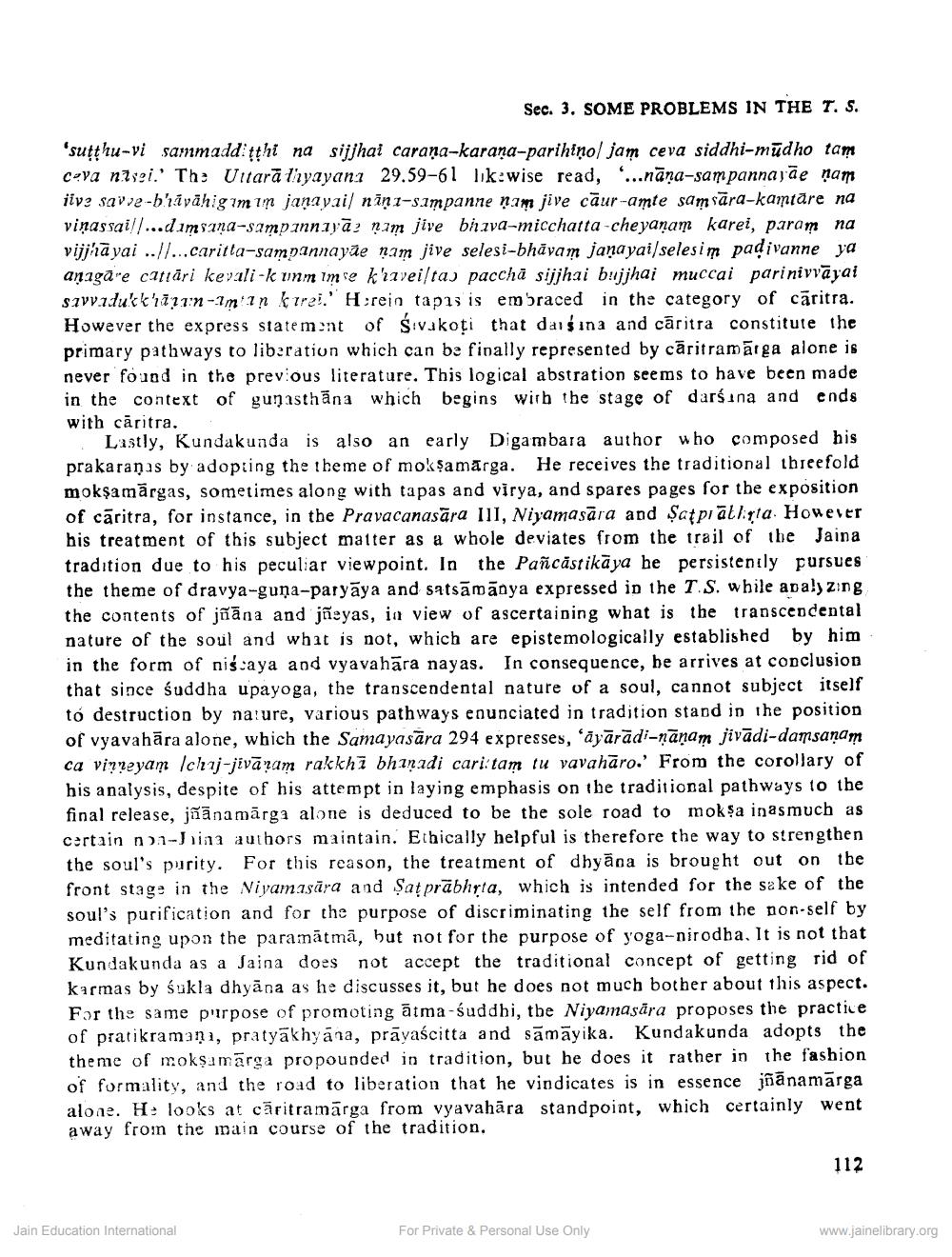________________
Sec. 3. SOME PROBLEMS IN THE T. S. 'sutthu-vi sammadd:ttht na sijjhat caraṇa-karaṇa-parihtno jam ceva siddhi-mudho tam ceva nisi. The Uttara lhyayana 29.59-61 likewise read, ...nāṇa-sampannayãe nam ilve save-bhāvāhigimin janayail nina-sampanne nam jive caur-amte samsara-kamāre na viņassai...damaṇa-sampannyā: nam Jive bhava-micchatta-cheyanam karei, param na vijjhayai.....caritla-sampannayae nam jive selesi-bhavam janayat/selesim padivanne ya anagare cautari kevali-kumm ime kazeiltas paccha sijjhai bujjhai muccai parinivvaya! savvadukkaan-aman kiral. Herein tapis is embraced in the category of cäritra. However the express statement of Sivakoti that daigina and caritra constitute the primary pathways to liberation which can be finally represented by caritramarga alone is never found in the previous literature. This logical abstration seems to have been made in the context of gunasthana which begins with the stage of darsina and ends with caritra.
Lastly, Kundakunda is also an early Digambara author who composed his prakaranas by adopting the theme of mokṣamarga. He receives the traditional threefold moksamärgas, sometimes along with tapas and virya, and spares pages for the exposition of caritra, for instance, in the Pravacanasära 111, Niyamasara and Satprälla. However his treatment of this subject matter as a whole deviates from the trail of the Jaina tradition due to his peculiar viewpoint. In the Pañcastikaya he persistently pursues the theme of dravya-guna-paryaya and satsamanya expressed in the T.S. while analyzing. the contents of jaana and jñeyas, in view of ascertaining what is the transcendental nature of the soul and what is not, which are epistemologically established by him. in the form of niscaya and vyavahāra nayas. In consequence, he arrives at conclusion that since suddha upayoga, the transcendental nature of a soul, cannot subject itself to destruction by nature, various pathways enunciated in tradition stand in the position of vyavahara alone, which the Samayasara 294 expresses, 'ayäräd-nāņam jivādi-damṣaṇam ca vineyam Ichaj-jivaram rakkhi bhaṇadi cari:tam tu vavaharo. From the corollary of his analysis, despite of his attempt in laying emphasis on the traditional pathways to the final release, jäänamärgs alone is deduced to be the sole road to moksa inasmuch as certain non-Jina authors maintain. Ethically helpful is therefore the way to strengthen the soul's purity. For this reason, the treatment of dhyana is brought out on the front stage in the Niyamasara and Satprabhṛta, which is intended for the sake of the soul's purification and for the purpose of discriminating the self from the non-self by meditating upon the paramātmā, but not for the purpose of yoga-nirodha. It is not that Kundakunda as a Jaina does not accept the traditional concept of getting rid of karmas by śukla dhyana as he discusses it, but he does not much bother about this aspect. For the same purpose of promoting ätma-suddhi, the Niyamasara proposes the practice of pratikramana, pratyakhyana, prayaścitta and samayika. Kundakunda adopts the theme of mokṣamärga propounded in tradition, but he does it rather in the fashion. of formality, and the road to liberation that he vindicates is in essence jñānamārga alone. He looks at cäritramarga from vyavahāra standpoint, which certainly went away from the main course of the tradition.
Jain Education International
For Private & Personal Use Only
112
www.jainelibrary.org




